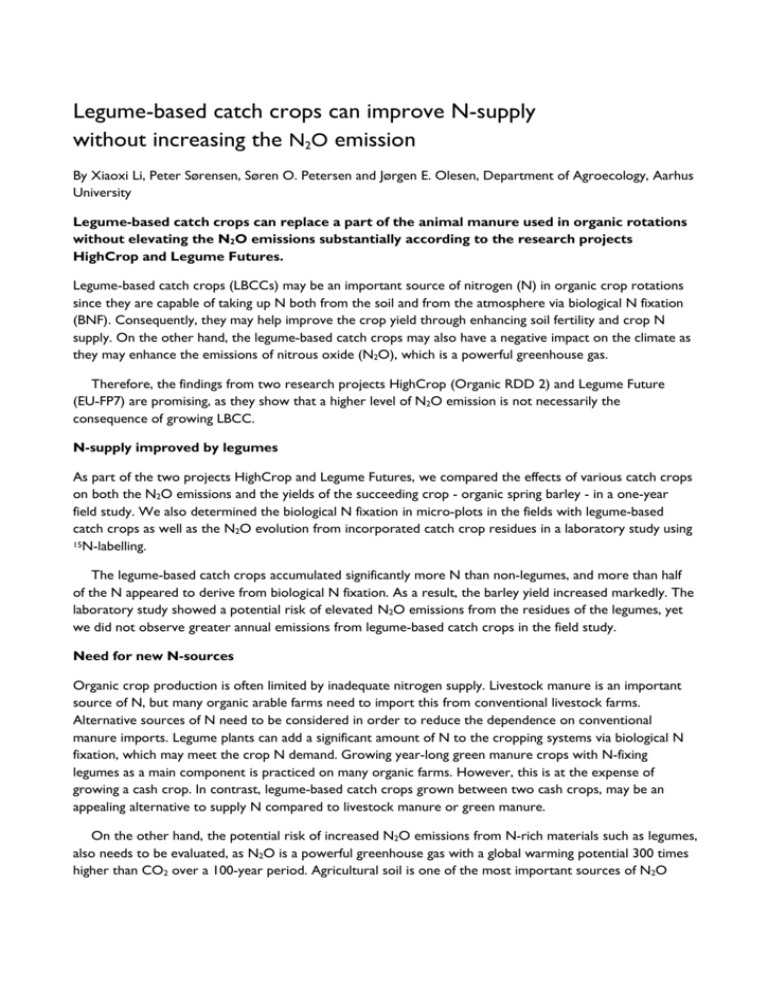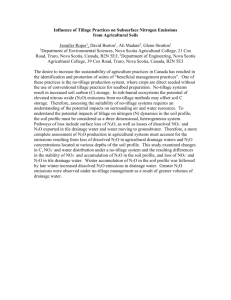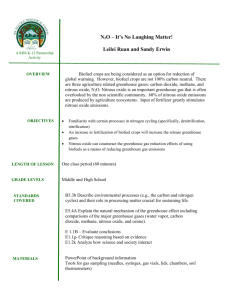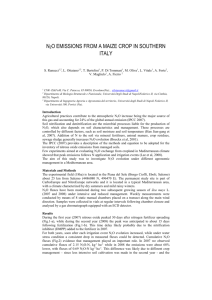Legume-based catch crops can improve N
advertisement

Legume-based catch crops can improve N-supply without increasing the N2O emission By Xiaoxi Li, Peter Sørensen, Søren O. Petersen and Jørgen E. Olesen, Department of Agroecology, Aarhus University Legume-based catch crops can replace a part of the animal manure used in organic rotations without elevating the N2O emissions substantially according to the research projects HighCrop and Legume Futures. Legume-based catch crops (LBCCs) may be an important source of nitrogen (N) in organic crop rotations since they are capable of taking up N both from the soil and from the atmosphere via biological N fixation (BNF). Consequently, they may help improve the crop yield through enhancing soil fertility and crop N supply. On the other hand, the legume-based catch crops may also have a negative impact on the climate as they may enhance the emissions of nitrous oxide (N2O), which is a powerful greenhouse gas. Therefore, the findings from two research projects HighCrop (Organic RDD 2) and Legume Future (EU-FP7) are promising, as they show that a higher level of N2O emission is not necessarily the consequence of growing LBCC. N-supply improved by legumes As part of the two projects HighCrop and Legume Futures, we compared the effects of various catch crops on both the N2O emissions and the yields of the succeeding crop - organic spring barley - in a one-year field study. We also determined the biological N fixation in micro-plots in the fields with legume-based catch crops as well as the N2O evolution from incorporated catch crop residues in a laboratory study using 15N-labelling. The legume-based catch crops accumulated significantly more N than non-legumes, and more than half of the N appeared to derive from biological N fixation. As a result, the barley yield increased markedly. The laboratory study showed a potential risk of elevated N2O emissions from the residues of the legumes, yet we did not observe greater annual emissions from legume-based catch crops in the field study. Need for new N-sources Organic crop production is often limited by inadequate nitrogen supply. Livestock manure is an important source of N, but many organic arable farms need to import this from conventional livestock farms. Alternative sources of N need to be considered in order to reduce the dependence on conventional manure imports. Legume plants can add a significant amount of N to the cropping systems via biological N fixation, which may meet the crop N demand. Growing year-long green manure crops with N-fixing legumes as a main component is practiced on many organic farms. However, this is at the expense of growing a cash crop. In contrast, legume-based catch crops grown between two cash crops, may be an appealing alternative to supply N compared to livestock manure or green manure. On the other hand, the potential risk of increased N2O emissions from N-rich materials such as legumes, also needs to be evaluated, as N2O is a powerful greenhouse gas with a global warming potential 300 times higher than CO2 over a 100-year period. Agricultural soil is one of the most important sources of N2O emissions, which is mainly produced during microbial processes of nitrification and denitrification. The N2O emissions from the soil are determined by the size of the N input and by the source of N, e.g., inorganic fertilisers or crop residues. N fixation and yield increase A field study was conducted on a loamy sand soil in Foulum, Denmark, in which we quantified and compared biological N fixation in red clover, grass-clover mixture and winter vetch, and their residual effects on spring barley in comparison with two catch crops without legumes in this case, perennial ryegrass and fodder radish, and a winter fallow. According to normal practice, the clover, grass and grass-clover catch crops were undersown in preceding spring barley in May 2012, while radish and vetch were sown the day after harvest of the barley in August 2012. All catch crops were ploughed down in April 2013, the day before sowing of spring barley without any fertilisation. Using 15N-labelling in micro-plots, the total N, BNF and soil N uptake in catch crops (tops and roots in 0–18 cm depth) were quantified in late autumn 2012. The results from the micro-plots (Table 1) showed that the three LBCCs tested accumulated about 153–226 kg N ha-1 including tops and roots in late autumn, and 51–59 pct. of the N derived from biological N fixation. This means 78–128 kg N ha-1 was added to the cropping systems by the legumes via N fixation. Table 1 Sources of N (biological N fixation or soil N) in catch crops (tops + roots) determined by 15N-labelling in field micro-plots in Oct. 2012 (Li et al., 2015b). No significant difference among treatments with same letter in each column (p<0.05). Catch crop Red clover Grass/clover Winter vetch Fodder radish Perennial ryegrass * BNF (%)* 55 a 59 a 51 a 0 0 -1 (kg N ha ) 125 a 128 a 78 a 0 0 Soil (kg N ha-1) 101 a 87 ab 75 b 96 a 71 b % of N in crop derived from BNF. On the other hand, the soil N uptake by LBCCs was comparable or even greater than that of nonLBCCs (Table 1). Although N leaching was not measured in this study, this result implies that LBCCs might be as effective in depleting soil N as commonly used ryegrass and radish catch crops, and thus preventing N leaching losses. It has to be noted that in this study the plants grew better inside the micro-plots than outside. It is well known that biological N fixation in legumes depends on biomass accumulation. Therefore, a high level of N fixation depends on well-established legumes. In our study we thus had less accumulated N in LBCCs in the larger plots than in the micro-plots. Table 2 shows a clear yield increase of unfertilised spring barley by use of LBCCs in comparison with nonLBCCs or bare fallow control. The barley following radish and ryegrass catch crops showed similar yield as the winter fallow treatment. The yield increase following LBCCs was mainly due to increased N supply as shown in Table 1. Also the more narrow C:N ratio of LBCCs compared to non-LBCCs meant that the accumulated N in LBCCs were relatively quickly mineralised and made available to the spring barley crop. Table 2 Grain yield of spring barley in 2013, annual N2O emissions (2012 Sep.–2013 Sep.), and yield-scaled emissions measured after use of different catch crops in a field experiment (Li et al., 2015a). No significant difference among treatments with same letter in each column (p<0.05). Catch crop Red clover Grass/clover Winter vetch Fodder radish Perennial ryegrass Control Grain yield (Mg ha-1) 4.5 a 4.5 a 4.1 ab 3.3 ac 2.6 c 2.8 bc Grain N yield (kg N ha-1) 72 a 70 a 65 ab 43 bc 35 c 34 c Annual N2O emissions (g N ha-1) 841 a 835 a 691 a 1180 a 509 a 801 a Yield-scaled emission (g N Mg-1 grain) 188 a 189 a 168 a 363 a 202 a 297 a N2O emissions Emissions of N2O were monitored over one year, from the growing period of catch crops to harvest of succeeding spring barley. The total N2O emissions from September 2012 to September 2013 are presented in Table 2. The emissions in LBCC treatments were not statistically different from those in non-LBCC and control treatments. However, with increased yields, the yield-scaled emissions in LBCCs tended to be lower than for the control and non-LBCC treatments. The fodder radish tended to be the largest emitter with highest emissions during winter. We carried out an additional lab study to examine the N2O evolution from incorporated catch crop residues during 28 days. The short period after residue incorporation is regarded as a “hot moment” for N2O emissions. Faster and greater N2O emissions were seen from the LBCC residues than the ryegrass or no-residue control (Fig. 1). This appeared to be a result of higher degradability and net N mineralization stimulating N2O formation. However, the potential of elevated emissions of N2O after incorporation of LBCC residues observed in the laboratory was not reflected in the field study where emissions over the entire year was not increased by the use of the legume-based catch crops. So in conclusion this study shows that the LBCC can improve crop yields without increasing N2O emissions in organic crop rotations. However, additional research is required to investigate the seasonal patterns and controlling factors of N2O emissions in catch cropping under field conditions in particular on different soil types, together with improved management for more sustainable crop production. Reference: Li, X.X., Petersen, S.O., Sørensen, P., Olesen, J.E., 2015a. Effects of contrasting catch crops on nitrogen availability and nitrous oxide emissions in an organic cropping system. Agriculture Ecosystems & Environment 199, 382-393. DOI: 10.1016/J.Agee.2014.10.016 Li, X.X., Sørensen, P., Li, F.C., Petersen, S.O., Olesen, J.E., 2015b. Quantifying biological nitrogen fixation of different catch crops, and residual effects of roots and tops on nitrogen uptake in barley using in-situ 15N labelling. Plant and Soil. (In press) DOI: 10.1007/s11104-015-2548-8 Fig. 1 Total N2O emissions accumulated after incorporation of different catch crop residues in a loamy sand soil in a laboratory study at different soil moisture contents. WFPS means water-filled pore space in soil. Photos can be used in the newsletter: Photo 1, chambers for N2O measurement in the field, 10/09/2012. Photo 2, spring barley following incorporation of different catch crops, 14/06/2013. Photo 3, micro-plots in winter vetch field to determine BNF using 15N-labelling, 03/09/2012. Photo 4, an incubation soil core with catch crop residue addition in a glass jar ready for N2O measurement, 13/04/2014 (lab study).






